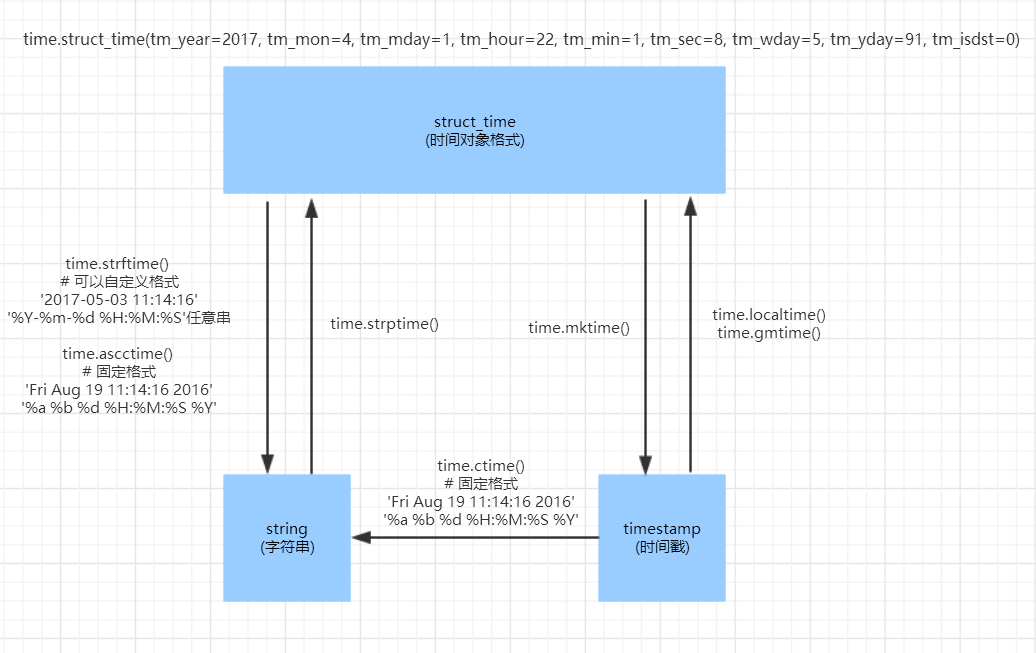time 模块
1 >>> import time 2 >>> time.time() 3 1491064723.808669 4 >>> # time.time()返回当前时间的时间戳timestamp(定义为从格林威治时间1970年01月01日00时00分00秒起至现在的总秒数)的方法,无参数 5 >>> time.asctime() 6 'Sun Apr 2 00:39:32 2017' 7 >>> # time.asctime()把struct_time对象格式转换为字符串格式为'Sun Apr 2 00:39:32 2017' 8 >>> time.asctime(time.gmtime()) 9 'Sat Apr 1 16:41:41 2017' 10 >>> time.asctime(time.localtime()) 11 'Sun Apr 2 00:42:06 2017' 12 >>> time.ctime() 13 'Sun Apr 2 00:42:29 2017' 14 >>> # time.ctime()把时间戳转换为字符串格式'Sun Apr 2 00:42:29 2017',默认为当前时间戳 15 >>> time.ctime(1491064723.808669) 16 'Sun Apr 2 00:38:43 2017' 17 >>> time.altzone # 返回与utc时间的时间差,以秒计算 18 -32400 19 >>> time.localtime() # 把时间戳转换为struct_time对象格式,默认返回当前时间戳 20 time.struct_time(tm_year=2017, tm_mon=4, tm_mday=2, tm_hour=0, tm_min=45, tm_sec=26, tm_wday=6, tm_yday=92, tm_isdst=0) 21 >>> time.localtime(1491064723.808669) 22 time.struct_time(tm_year=2017, tm_mon=4, tm_mday=2, tm_hour=0, tm_min=38, tm_sec=43, tm_wday=6, tm_yday=92, tm_isdst=0) 23 >>> 24 >>> time.gmtime() # 将utc时间戳转换成struct_time对象格式,默认返回当前时间的 25 time.struct_time(tm_year=2017, tm_mon=4, tm_mday=1, tm_hour=16, tm_min=46, tm_sec=32, tm_wday=5, tm_yday=91, tm_isdst=0) 26 >>> time.gmtime(1491064723.808669) 27 time.struct_time(tm_year=2017, tm_mon=4, tm_mday=1, tm_hour=16, tm_min=38, tm_sec=43, tm_wday=5, tm_yday=91, tm_isdst=0) 28 >>> 29 >>> 30 >>> time.strftime('%Y-%m-%d %H:%M:%S', time.localtime()) # 将本地时间的struct_time格式转成自定义字符串格式 2017-04-01 23:15:47 31 '2017-04-02 00:47:49' 32 >>> 33 >>> time.strftime('%Y-%m-%d %H:%M:%S', time.gmtime()) # 将utc时间的struct_time格式转成自定义字符串格式 2017-04-01 23:15:47 34 '2017-04-01 16:48:27' 35 >>> 36 >>> time.strptime('2017-04-02 00:47:49', '%Y-%m-%d %H:%M:%S') # 将 日期字符串 转成 struct_time时间对象格式,注意转换后的tm_isdst=-1()夏令时状态 37 time.struct_time(tm_year=2017, tm_mon=4, tm_mday=2, tm_hour=0, tm_min=47, tm_sec=49, tm_wday=6, tm_yday=92, tm_isdst=-1) 38 >>> 39 >>> time.mktime(time.localtime()) 40 1491065416.0 41 >>> # 将struct_tiame时间对象转成时间戳 结果返回1491061855.0 ,忽略小于秒的时间(忽略小数点后面) 42 >>> 43 >>> time.mktime(time.localtime(1491061855.0011407)) 44 1491061855.0 45 >>> # 结果返回1491061855.0 ,忽略小于秒的时间(忽略小数点后面) 46 >>> 47 >>> time.mktime(time.gmtime(1491061855.0011407)) 48 1491033055.0 49 >>> 50 >>> # 结果返回1491033055.0 ,忽略小于秒的时间(忽略小数点后面) 51 >>>
时间转换关系图

格式字符及意义
%a 星期的简写。如 星期三为Web
%A 星期的全写。如 星期三为Wednesday
%b 月份的简写。如4月份为Apr
%B月份的全写。如4月份为April
%c: 日期时间的字符串表示。(如: 04/07/10 10:43:39)
%d: 日在这个月中的天数(是这个月的第几天)
%f: 微秒(范围[0,999999])
%H: 小时(24小时制,[0, 23])
%I: 小时(12小时制,[0, 11])
%j: 日在年中的天数 [001,366](是当年的第几天)
%m: 月份([01,12])
%M: 分钟([00,59])
%p: AM或者PM
%S: 秒(范围为[00,61],为什么不是[00, 59],参考python手册~_~)
%U: 周在当年的周数当年的第几周),星期天作为周的第一天
%w: 今天在这周的天数,范围为[0, 6],6表示星期天
%W: 周在当年的周数(是当年的第几周),星期一作为周的第一天
%x: 日期字符串(如:04/07/10)
%X: 时间字符串(如:10:43:39)
%y: 2个数字表示的年份
%Y: 4个数字表示的年份
%z: 与utc时间的间隔 (如果是本地时间,返回空字符串)
%Z: 时区名称(如果是本地时间,返回空字符串)
datetime模块,方便时间计算
1 >>> import datetime 2 >>> datetime.datetime.now() 3 datetime.datetime(2017, 4, 7, 16, 52, 3, 199458) 4 # 返回一组数据(年,月,日,小时,分钟,秒,微秒) 5 6 >>> print(datetime.datetime.now()) 7 2017-04-07 16:52:55.000164 8 # 打印返回格式(固定) 9 10 >>> datetime.datetime.now()+datetime.timedelta(days=3) 11 datetime.datetime(2017, 4, 10, 16, 53, 51, 180847) 12 # 时间加(减),可以是日,秒,微秒,毫秒,分,小时,周 13 #days=0, seconds=0, microseconds=0,milliseconds=0, minutes=0, hours=0, weeks=0 14 >>> print(datetime.datetime.now()+datetime.timedelta(weeks=1)) 15 2017-04-17 16:54:08.916243 16 17 >>> datetime.datetime.now().replace(minute=3,hour=2) 18 datetime.datetime(2017, 4, 7, 2, 3, 11, 163663) 19 # 时间替换 20 21 >>> datetime.datetime.now() 22 datetime.datetime(2017, 4, 7, 16, 58, 22, 195439) 23 24 >>> datetime.datetime.now().replace(day=1,month=1) 25 datetime.datetime(2017, 1, 1, 16, 59, 13, 210556) 26 >>> 27 # 直接替换相应位置数据
random模块
import random >>> print(random.random()) 0.5364503211492734 >>> print(random.randint(1,10)) 3 >>> # 整数1-10(包括10),随机取一个值 >>> >>> >>> >>> print(random.randrange(1, 10)) 8 >>> # 整数1-10(不包括10),随机取一个值
1 import random 2 3 checkcode = '' 4 for i in range(6): 5 current = random.randrange(0, 6) 6 if current != i and current+1 != i: 7 temp = chr(random.randint(65, 90)) 8 # 65-90是A-Z 9 elif current+1 == i: 10 temp = chr(random.randint(97, 122)) 11 # 97-122是a-z 12 else: 13 temp = random.randint(0, 9) 14 checkcode += str(temp) 15 print(checkcode) 16 17 # 一共6位验证码, 18 # 第一位有1/6几率是数字,其它都是大写字母 19 # 第二到第六位,都是有1/6几率是小写字母,1/6几率是数字,其它都是大写字母
OS模块
提供对操作系统进行调用的接口
1 os.getcwd() 获取当前工作目录,即当前python脚本工作的目录路径 2 os.chdir("dirname") 改变当前脚本工作目录;相当于shell下cd 3 os.curdir 返回当前目录: ('.') 4 os.pardir 获取当前目录的父目录字符串名:('..') 5 os.makedirs('dirname1/dirname2') 可生成多层递归目录 6 os.removedirs('dirname1') 若目录为空,则删除,并递归到上一级目录,如若也为空,则删除,依此类推 7 os.mkdir('dirname') 生成单级目录;相当于shell中mkdir dirname 8 os.rmdir('dirname') 删除单级空目录,若目录不为空则无法删除,报错;相当于shell中rmdir dirname 9 os.listdir('dirname') 列出指定目录下的所有文件和子目录,包括隐藏文件,并以列表方式打印 10 os.remove() 删除一个文件 11 os.rename("oldname","newname") 重命名文件/目录 12 os.stat('path/filename') 获取文件/目录信息 13 os.sep 输出操作系统特定的路径分隔符,win下为"\",Linux下为"/" 14 os.linesep 输出当前平台使用的行终止符,win下为" ",Linux下为" " 15 os.pathsep 输出用于分割文件路径的字符串 16 os.name 输出字符串指示当前使用平台。win->'nt'; Linux->'posix' 17 os.system("bash command") 运行shell命令,直接显示 18 os.environ 获取系统环境变量 19 os.path.abspath(path) 返回path规范化的绝对路径 20 os.path.split(path) 将path分割成目录和文件名二元组返回 21 os.path.dirname(path) 返回path的目录。其实就是os.path.split(path)的第一个元素 22 os.path.basename(path) 返回path最后的文件名。如何path以/或结尾,那么就会返回空值。即os.path.split(path)的第二个元素 23 os.path.exists(path) 如果path存在,返回True;如果path不存在,返回False 24 os.path.isabs(path) 如果path是绝对路径,返回True 25 os.path.isfile(path) 如果path是一个存在的文件,返回True。否则返回False 26 os.path.isdir(path) 如果path是一个存在的目录,则返回True。否则返回False 27 os.path.join(path1[, path2[, ...]]) 将多个路径组合后返回,第一个绝对路径之前的参数将被忽略 28 os.path.getatime(path) 返回path所指向的文件或者目录的最后存取时间 29 os.path.getmtime(path) 返回path所指向的文件或者目录的最后修改时间
sys模块
用于提供对解释器相关的操作
1 sys.argv 命令行参数List,第一个元素是程序本身路径 2 sys.exit(n) 退出程序,正常退出时exit(0) 3 sys.version 获取Python解释程序的版本信息 4 sys.maxint 最大的Int值 5 sys.path 返回模块的搜索路径,初始化时使用PYTHONPATH环境变量的值 6 sys.platform 返回操作系统平台名称 7 sys.stdout.write('please:') 8 val = sys.stdin.readline()[:-1]
datetime模块
1 print(datetime.datetime.today()) #获取当前时间,到秒 2 print(datetime.datetime.now()) #和today一样 3 4 res = datetime.datetime.today().strftime('%Y-%m-%d') #格式化好的时间 5 print(res) 6 7 res= datetime.datetime.today()+datetime.timedelta(-3) #3天前的时间 8 res= datetime.datetime.today()+datetime.timedelta(3) #3天后的时间 9 print(res) 10 11 print(datetime.date.today()) #去当天的日期,只是日期